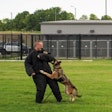Gang activity continues to steadily rise throughout the United States, despite law enforcement’s attempts to deal with the epidemic. It’s like a cancer that begins in a vital organ and then spreads its deadly cells throughout the body, defying efforts to eradicate the disease. Gangs are spreading to every small town, village, and city in the country. No one is immune and law enforcement is scrambling to get on top of the problem.
Dealing with gangs has become a priority for many law enforcement agencies. The public often makes this job more difficult by believing, “It’s not a problem in our neighborhood.” While each department has its own method of combating the gang problem, some of the basics remain the same.
The most essential tool, departments say, is communication—communication among law enforcement agencies, and law enforcement’s communication with parents, community leaders, schools, and current and prospective gang members.
Starting at the Beginning
Sometimes the best tactic is to stop a problem before it starts. Some police agencies are finding ways to keep kids from joining gangs.
Det. Rick Rodriguez of the Arlington County (Va.) Sheriff’s Office says his agency’s communication campaign began on a simple level.
“In 1997 we were getting frustrated seeing these young juveniles out at three in the morning when they should have been home,” Rodriguez says.
After watching these kids and taking reports, he visited their parents’ homes and was surprised at the reception he got. The families hadn’t known what their children were doing, and they were not aware of the signs of gang involvement. But they were willing to learn.
After this revelation, the department began educating parents on what to look for so they could keep their kids out of gangs or get them out before it was too late.
The same parents Rodriguez and his colleagues first contacted then took it upon themselves to become more involved. They recommended that gang officers meet with all local parents as a group, not just individually. As a result of these meetings, the parents began a network through which they could police their kids on their own. “If Johnny said he was going to Mario’s house his parents could follow up and call,” Rodriguez explains.
Parents also asked local police officers to speak with their kids to scare them with the truth.
“We said, ‘Yes,’” says Rodriguez. “We wanted these kids to understand what it’s really like to be a gang member: you will end up in jail, in the hospital, or in the cemetery.”
Rodriguez found one of the biggest problems was that most of the kids becoming involved in gangs in Arlington County came from single-parent homes where the parent had to work more than one job. This meant that however much these parents wanted to be involved in their children’s lives, they weren’t able to stay home and keep an eye on them.
To help compensate for a lack of supervision at home, the agency’s program has since expanded to include school officials, teachers, and counselors. These participants have been instructed on how to identify gang members and how to mediate if rival gang members are in the same class.
“We made the gang members aware that we looked at them from the street, from home, and from school,” Rodriguez says. “Our main goal was to break the cycle of recruitment; if we could disrupt the cycle then we were winning.”
But even with all this help at the ground level, it’s tough to fight the glamorous image many youth associate with the gang lifestyle. “Realistically, with the media, with ‘gangsta rap’ and some of the movies and video games out there, it’s hard to compete with what the kids see,” says Rodriguez.
In rural areas it can be even more of a struggle to convince the community to combat a gang problem, because they usually don’t want to believe it exists.
[PAGEBREAK]
Taking Back Rural Areas
Hunter Glass, a detective with the Fayetteville (N.C.) Police Department, found a unique way to convince citizens that gangs were in their town. Because Fayetteville is a small city, many residents were in denial about the presence of gangs. His department had to find ways to overcome this denial, and it found success with the use of video cameras, facilitated by school officials.
“We did a lot of video taping,” says Glass. “When we deal with the parents who say, ‘It’s not my kid,’ when they look at the video it’s kind of difficult for them to dispute.”
According to Glass, his department initially received a very negative reaction from the parents. They accused him of being prejudiced against all types of groups. But tapes that caught teens on tape painting graffiti and committing other crimes at school convinced parents otherwise.
“I told them, ‘Don’t look at me; just look at the video behind me,’” he says. “You should have seen their faces and the looks on the kids. It reduced the amount of activity in that school by virtue of that one act.”
Working with parents and schools is an important part of combating gang activity, especially in small towns. And it doesn’t always require video tape.
In order to deal with the recent gang influx in Dubuque, Iowa, Lt. Dan Avenarius of the Dubuque Police Department says his agency had to gear up quickly, and that meant enlisting the help of the locals.
“Gangs are pretty smart in adapting to proactive programs that police and communities have,” Avenarius says. “They develop counter measures. The smarter we get, the smarter they get.”
Avenarius says that, especially in a smaller town where gangs have not traditionally been a problem, it’s important for law enforcement agencies to inform the public about gangs and gang activity.
“We need to educate the public that just because they are not seeing things happen on the street corner every day it doesn’t mean we don’t have a problem. Law enforcement agencies need to continue to do a better job of communication,” he says.
But letting the public know that gangs exist in their area is not enough. For citizens to contribute to the solution, they must continue to monitor gang activity and alert law enforcement to any differences they notice.
“I think there need to be a couple of approaches,” says Avenarius. “Communities and law enforcement need to be on a constant vigil for what is changing in their community. What are the signs of gangs or lack of signs?”
But he warns that giving citizens information about gangs in their area must be handled delicately.
“When we educate the public we need to deal with it carefully or we could wind up causing paranoia or fear,” he says. “We need to tell them in a calm, rational manner that these are the things we need to be concerned about, not that things are out of control. Then we need to ask for their help.”
Police officers can’t be the only ones to get involved, as Rodriguez and Glass discovered. The entire community needs to join the fight, including schools.
“The streets and the schools mirror each other,” Avenarius says. “You need to involve school officials.”
Communities shouldn’t forget, however, to be on the lookout for older gang members that are out of school, as well. The kids that join gangs grow up to recruit new members. And when convicted members newly out of jail return home, they continue the process.
Putting Them Away
More than 1,800 federal buildings in the Los Angeles area fall under the jurisdiction of the U.S. Federal Protective Service, under the Department of Homeland Security.
Officer Roman Morales says he has seen a growing gang problem there and it’s not getting better.
“I see more in the future. For the longest time, our agency and others had the mentality that it was not our problem. As we started to look into it, more and more surfaced until we realized it is our problem as well."
The service’s biggest asset in gang suppression, Morales says, is stricter sentencing. “We tell them we are not the locals, we are the feds. When we hit, we hit them harder.”
On the East Coast, federal authorities are also joining the fight to get gangs behind bars. On Long Island, the F.B.I. has recently taken charge of a task force that brings together County police agencies, the New York State Police, and dozens of local agencies in villages and cities. And while they make gang arrests whenever possible, their goal is more forward-looking.
According to Special Agent Bob Hart, “What we are attempting to do is build long-term racketeering cases against gangs, viewing them as criminal enterprises. By doing so, showing structure, a mission, a purpose, we are able to bring them into the federal court system under RICO statutes.” Under RICO, gang members are put away for a much longer period of time than they would be for crimes prosecuted individually.
With the cooperation of the U.S. Attorney’s office of the Eastern district of New York, Hart says these gang members are prosecuted to the fullest extent of the federal statutes. He says the success and cooperation of the task force is “unprecedented and just fantastic” and sees it as an effective tool for use in the long-term suppression of gangs.
But putting a gang member away doesn’t necessarily mean he’s not a threat.
[PAGEBREAK]Working with Corrections
One major player in the game of combating gangs is corrections. Keeping tabs on incarcerated gang members can give hints as to what’s going on in the outside world and can even help to curb convicts’ influence on the streets.
“Just because a person is incarcerated doesn’t mean he’s not recruiting,” says Arlington County’s Rodriguez. “It doesn’t mean he’s not giving out an order. Being locked up is just a temporary bump in the road for someone who’s determined to make a career out of criminal activity.”
A program in Orange County, Florida, seeks to join the expertise and intelligence of gang officers and corrections officers in a program that monitors gang members on the inside as well as on the streets.
According to Rusty Keeble, Commander of the office of security intelligence for the Orange County (Fla.) Corrections Department, Florida has been rated as the state with the most significant increase in gangs in the past 20 years. This is a title the state is working hard to get rid of, with help from its monitoring program.
In addition to its own gang unit, the Orange County Sheriff’s Office has an exclusive relationship with a gang unit from the Corrections Department that monitors the known gang areas in the county.
“Wherever gang members meet, they always see one of our gang investigators there,” says Keeble.
The Orange County Corrections Department is, according to Keeble, one of the first in Florida to initiate a gang unit that works with the local sheriff’s department. And so far, it’s been successful.
“I have 15 intelligence officers in the jail that are out there making human contact with gang members on a daily basis,” says Keeble. “They develop intelligence, know what gangs are doing, what the new trends are, where they hang out.”
These officers communicate on a daily basis with the Sheriff’s Office personnel, either via computer or telephone.
Once a gang member is released, the information is communicated to the Sheriff’s Office. The Sheriff’s Office then contacts the gang member.
“There is nothing more efficient than, within 24 or 48 hours of release, a deputy knocking on your door and saying he knows you’re home now. It is a tremendous resource in terms of suppression,” says Keeble.
Inside the jail, corrections officers strictly monitor gang members and gang activity. Any type of gang activity is punished by disciplinary charges that can result in lengthened sentences. Intelligence is gathered by monitoring telephone conversations, visitors, and correspondence.
“During the monitoring phase,” says Keeble, “we find out if inmates are communicating with known gang members, discussing new meeting times or dates, new trends, or color changes. Then we inform the Sheriff’s Department.”
If an inmate who was held in Orange County is convicted and enters the state prison system, information from both the Orange County Sheriff’s Office and county corrections follows him or her into the system. The Department of Corrections picks it up and continues the monitoring and notification process.
“The prison system notifies us when a state inmate is about to be released,” Keeble says. “We have somebody in intelligence standing in every door of the criminal justice system ready to greet him.”
Keeping Track of Gangs
Gangs have become increasingly mobile, migrating from one jurisdiction to another and from state to state. Rodriguez has encountered gangs in Virginia that have come from Dallas, Texas; Raleigh; Miami; and New York. Therefore, communication among departments has become an essential tool in the war against gangs.
“We have to network and pass on information at critical points so that intel is received in a timely fashion,” says Rodriguez. “If we meet only once a month, then it’s old news. If we have contacts at other agencies, we can pass our info along quickly, whether by e-mail or telephone. We can let them know if a known gang member is in their jurisdiction and even send photographs so this person is no longer an unknown figure.”
Dubuque, Iowa, is located approximately three hours from Chicago, and while the area remains basically rural, local law enforcement has seen evidence of what Avenarius, who is also chairman of the Midwest Gang Investigators Association, describes as “every type of gang in the country.”
Avenarius believes that gangs chose Dubuque because it had been a relatively safe area with a low crime rate, providing new territory where they wouldn’t be immediately recognized and targeted by police.
More gangs are traveling to places seen as a safe haven, which is why working with cops across a state and in bigger cities more familiar with gang crimes can be so beneficial.
For Fayetteville PD, the Northeast Gang Investigators Association has become an important part of the department’s gang suppression techniques. “We have a real unique system across North Carolina,” says Glass. “They can call us or e-mail us. There is a constant communication between departments.”
Glass has found that communication with local departments can help find a gang member that may have moved not that far away.
“Gang members have a tendency to travel, especially through foster homes,” Glass says. “So, it’s much simpler if you pick up the phone and call another department.”
Crime analysts work closely with the Fayetteville gang unit, as well. According to Glass, they’re an important asset in finding gang-related crimes because they notice trends and crime hotspots.
In Memphis, Lt. Dale Lane of the Shelby County Sheriff’s Office is president of the Tennessee Gang Investigators Association, a gang task force that includes correction officers and representatives of the U.S. Attorney’s office. They meet weekly. In addition, they work through Project Safe Neighborhoods, where the U.S. Attorney’s office reviews every firearms-related arrest.
“We also use covert operations to monitor gang leadership,” Lane says. “Once we I.D. gang members we work together to try to work from the top down. We try to cut the command and control off from the top.”
With all of these alliances among agencies, it’s easy to think that you’ll always be able to get the information you need. But updating information and maintaining the information you’ve collected can be equally important.
“You can’t collect information today and expect it to be good six months from now,” says Glass. “But you should always hold on to it because it may resurface. Once information is opened, it should never be closed. Even if the person dies, never close it. It needs to remain open for intelligence purposes. A homicide can occur ten years later because a little brother wants to take revenge.”
Looking Forward
The consensus of gang experts is that, despite their best efforts, in many cases, the best most departments can hope for is to keep the gang problem under control. And in many areas, gang activity continues to escalate.
According to Rodriguez, while the gang problem continues to increase in Virginia, he has to wonder what the reasons are behind it and what he and other cops can do—that they aren’t already doing—to stop it. He believes that, as a society, we must get to the core of the problem.
“Gangs are groups of individuals who are failures,” Rodriguez says, “either by their own fault or through their environment, and all they are doing is validating each other’s failures. We have to come up with a way to get the message out that joining a gang will get you nowhere. It may sound exciting, but in reality it can take your individuality and your life.”
If treated early gangs can often be controlled. If they are allowed to spread, they will take over communities, committing crimes and taking away a generation of our children. Law enforcement is the first line of defense in this battle.
Cooperation among agencies, constant communication and education, and zero tolerance are essential tools in fighting the war against gangs on your streets.
















